Ukraine's Iron Dome: How Ukrainian military destroys Russian missiles with German Gepards
 Ukrainian soldier on a Gepard (photo: Vitalii Nosach/RBC-Ukraine)
Ukrainian soldier on a Gepard (photo: Vitalii Nosach/RBC-Ukraine)
The German Gepard self-propelled artillery systems used by the Ukrainian military today can hit targets at a distance of up to 4 km. These systems protect cities and important infrastructure from attacks by missiles and Iranian drones. RBC-Ukraine's article describes how the Ukrainian Air Force deals with German equipment.
On the turret of the Gepard tank, there are 5 silhouettes of Shaheds and 3 cruise missiles stenciled on the turret - this marking means that this anti-aircraft system has hit the same number of air targets. We arrived at the location of a mobile air defense group in the Kyiv region.
The crew commander, a man with the call sign Buba, says it took him and his comrades a little over a month to master the Gepard. This is ten times less time than the time it takes in Germany.
"My specific job is to detect and destroy enemy air targets. Shaheds, missiles. I have never downed airplanes, but I would like to. We do not destroy all targets. We cannot destroy ballistic missiles. But we shoot down cruise missiles, Shaheds, and generally short-range drones."
 Photo: RBC-Ukraine
Photo: RBC-Ukraine
A roar breaks the silence - the last preparations are underway. A mechanic inspects the Gepard. This is a giant installation on the chassis of a Leopard-1 tank. The German-made iron monster in Ukraine performs a crucial mission, as its crew defends cities from Shaheds attacks.
Buba is from the Kharkiv region. He joined the unit a year and a half ago. During this time, he managed to destroy more than a dozen enemy air targets. The soldier is proud to talk about the number of targets he has shot down: in a year and a half, he has hit three cruise missiles and dozens of Iranian UAVs.
- Recently, we shot down a lot of Shaheds. They covered us closely from day to day. That is, we worked the night, slept, recharged, and then it was night again, and we were shooting again. And so close, probably for 20 days, every day.
- So the enemy has become more active in the airspace?
- Yes, they are becoming more active in all directions. They are also learning, I would say. They are smart, and we shouldn't underestimate them or say that they are completely stupid. They understand everything.
It's harder to hit the black Shaheds, who have appeared relatively recently, but it's possible. Buba says that this one takes more ammunition. Nevertheless, we can see their downed "skeletons" in the photos in the reports.
Although Buba is a commander, depending on the conditions, he can also perform the functions of a shooter, because teamwork is very important. If the targets are in a group, one of the soldiers points at one, and Buba focuses on the other. Thus, one mobile group can shoot more targets in a shorter time.
The multi-ton anti-aircraft system starts moving. The tracked chassis is easy to move off-road. The giant tower makes a complete rotation around its axis. It is equipped with two 35 mm cannons and two radars that can detect targets at a distance of up to 15 km.
 Photo: RBC-Ukraine
Photo: RBC-Ukraine
Yevhen with the call sign Veles is a driver of a Gepard 1A2 modification. He shows us the unit up close and even allows us to climb on the chassis. While we are looking at the Gepard, Veles tells us about himself. In his civilian life, he was a driver, but he drove a truck, so it was not difficult for him to master the Gepard - the only question was its size and weight. Now his task is to successfully take up a combat position, prepare aviation devices for combat work to make it easier for the guys to capture combat targets, and search for other targets.
"This equipment is quite comfortable. If we compare it with the Soviet "caterpillar", this heaven and earth are much easier to control. It has better driving characteristics, a softer ride, and a powerful engine. It's all-terrain, with enough power for both sandy roads and hard ground."
At a combat position, the military first tracks targets with one radar and then captures them with the other. The system is automated - it searches and aims by itself. The shooter's task is narrowed down to successfully capturing a missile or drone, and then it's up to the computer. As soon as a Shahed is in the target area, the commander gives the "fire" command.
"We are currently using high-explosive charges. To have a 100 percent chance of hitting the target, I, as a driver, need to take the best possible combat position as close as possible and quickly as possible."
 Photo: RBC-Ukraine
Photo: RBC-Ukraine
In the Gepard's turret, there is a cockpit for the gunner and the gunner, and we are allowed to climb inside and see what the air defenders see in front of us. The Ukrainian Armed Forces modification 1 A2 has a digital computer. Veles shows us which levers and buttons are responsible for fire control and shell release, but with a smile asks us not to tell anyone about it. We promise to keep quiet and look through the sighting device: the horizon is clear, and there are no enemy drones.
For a successful hit, the military sometimes lets the target come within a kilometer and a half, although they can open fire from as little as four kilometers away. When asked if it's scary, the military only laughs.
"Unfortunately, our enemy is very good at learning, they are constantly modernizing their missiles, Shaheds, they have radars now, and they can also detect at a long distance. Now, to destroy them better, we are trying to get them as close as possible."
Before we say goodbye, we ask how the soldiers feel when they manage to repel an attack. The answer is obvious, but at first, Buba doesn't say it's joy.
"I feel responsible. We do have a responsibility to ensure that people sleep peacefully. But that doesn't mean we should ignore alarms. If there is anxiety, it is better to hide. "Stay away from sin," as they say!"
 Photo: RBC-Ukraine
Photo: RBC-Ukraine
Today, there is almost no place to hide from "sin," that is, from the Russian missiles that the enemy is firing at Ukraine. Unless it's behind the backs of Ukrainian Air Defense Forces, where it's safer.

